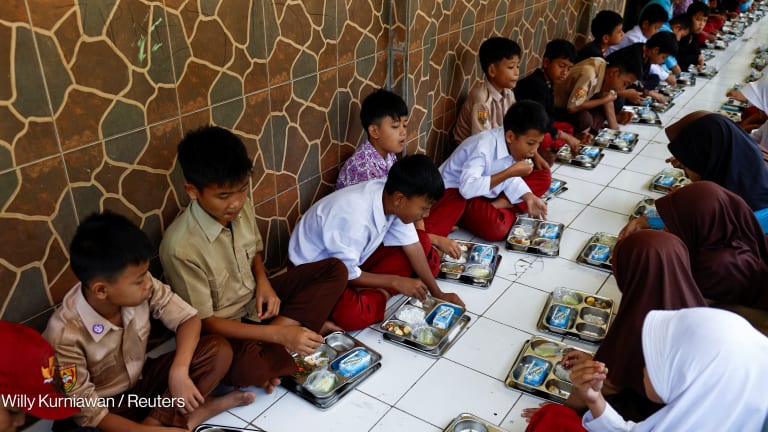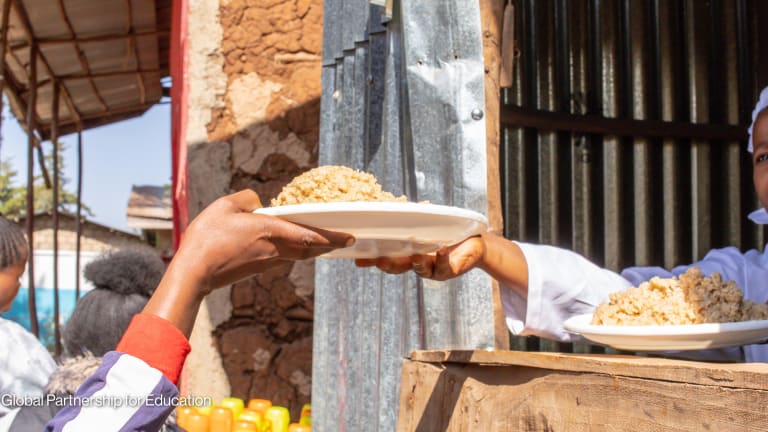
To ensure pledges made in 2021 around improving nutrition outcomes come to fruition, advocates say the nutrition community must now focus on diversifying financing mechanisms and accountability, along with effectively communicating the urgency of nutrition progress to a broader audience.
2021 was deemed a “year of action” for nutrition, with the United Nations Food Systems Summit and the Nutrition for Growth Summit, or N4G, bringing together not only traditional advocates but people from across the food system, highlighting the need to link different agendas to make progress. Continuing that momentum will require an even broader understanding of nutrition’s importance for all aspects of global development, according to Simon Bishop, the chief executive officer at The Power of Nutrition.
Get the inside track on how agriculture, nutrition, sustainability, and more are intersecting to remake the global food system in this weekly newsletter.
“We’ve got to continue to make sure that we’re making the case effectively that nutrition is relevant to these big other issues … [such as COVID-19], climate change, education,” he said. This means “making the case that we will not achieve any global education targets if children are turning up on day one at school stunted, or once they’re in school they’re not getting decent nutrition to be able to learn.”
“We can be a bit inward-looking, and we’re seen by others in the international development environment as nutrition geeks, talking about ‘nutrition-sensitive’ versus ‘nutrition-specific,’” Bishop continued. “We don’t go out there and talk enough to the private sector.”
In addition to showing the relevance of nutrition to other sectors, Bishop said nutrition must “go where the money is” and explore innovative financing, particularly as COVID-19 has strained both national and donor resources.
In 2020, over 100 million additional people went hungry amid the pandemic, with conflict and climate change also compounding food crises around the world. Obesity and overweight are on the rise — which, together with undernutrition, is increasing the impact of the “double burden of malnutrition.”
Estimates show that meeting Sustainable Development Goal 2 — ending hunger by 2030 — could cost as much as $50 billion a year. Currently less than 1% of global aid goes toward nutrition, according to Bishop, and nutrition has only one “tiny” impact fund, compared with five for health.
“We’re already way behind other sectors in getting into this innovative financing space. That’s where we really want to be pioneers. We don’t want to be orphans,” Bishop said. “We really need to stop dabbling in this area and really go into it in a big way. We’ve had $42 billion of COVID capital market bonds launched. If you can launch capital market bonds in COVID, you must be able to do it in nutrition.”
Philanthropies are also making a concerted effort to boost financing. Stronger Foundations for Nutrition is a coalition of philanthropies that came together in 2017 to build stronger relationships among those working on the issue. About a year ago, the group decided that its coordination needed to be formalized and funded, which eventually led to the hiring of Matt Freeman as executive director.
Stronger Foundations for Nutrition currently has 15 members. These include philanthropies well known in the nutrition space, such as the Bill & Melinda Gates Foundation and Eleanor Crook Foundation, along with those less established in the sector, such as Tata Trusts and Rotary International.
“The community for nutrition philanthropy has been so small and obviously not nearly enough,” Freeman said. So the coalition aims to “really grow that community and really broaden that community to attract philanthropists and corporate foundations … more historically focused on climate or agriculture or maternal health and child survival,” establishing a space “where they can participate in the role that nutrition plays in all of those things.”
“What we’re trying to do is just create a space to build relationships and share learning amongst as many people and organizations who want to be a part of that,” he added.
Nutrition can look to other sectors that have had success in philanthropic fundraising, such as climate change and health, Freeman said. For example, one model is exemplified by the role that the Gates Foundation and Rotary International played in financing polio eradication efforts.
“The dream would be that nutrition is the new polio, and we are activating communities at that kind of scale all over the world,” Freeman said.
Embedding nutrition into investments in other sectors will also be key to attaining the necessary resources, according to Margaux Stastny, vice president of external relations at Nutrition International. This requires work at the country level, she said, to provide technical support for the development of costed, evidence-based plans to improve nutrition outcomes.
“We’ve got to continue to make sure that we’re making the case effectively that nutrition is relevant to these big other issues … [such as COVID-19], climate change, education.”
— Simon Bishop, the chief executive officer, The Power of Nutrition.Her organization is also focused on accountability for announcements made during last year’s Food Systems Summit and N4G. It will be important to utilize the Nutrition Accountability Framework, a mechanism launched in September as part of the “Global Nutrition Report” to track N4G commitments. It aims to balance reporting requirements so they are rigorous enough to provide an accurate picture while not being so onerous that countries and organizations don’t bother reporting at all.
Only 42% of country commitments made at past N4G summits have been reached or are on track, according to the “Global Nutrition Report.”
“It’s not only about whether you said you were going to spend X money. You spent X money. But what happened to that money? What did we get for it?” Stastny said. “So we can track the impact of the money that’s been allocated. That is an area where we still have some work to do,” she added.
“We need more funding, but start with making sure the funding that we have is going where it can have the greatest impact and making sure that we’re investing in places that are really evidence-based in the impact that they can have.”









